| dc.contributor.author | Gomes, Tania | |
| dc.contributor.author | Song, You | |
| dc.contributor.author | Brede, Dag Anders | |
| dc.contributor.author | Xie, Li | |
| dc.contributor.author | Gutzkow, Kristine Bjerve | |
| dc.contributor.author | Salbu, Brit | |
| dc.contributor.author | Tollefsen, Knut Erik | |
| dc.date.accessioned | 2019-06-26T06:46:53Z | |
| dc.date.available | 2019-06-26T06:46:53Z | |
| dc.date.created | 2018-02-14T16:34:50Z | |
| dc.date.issued | 2018 | |
| dc.identifier.citation | Science of the Total Environment. 2018, 628-629 206-216. | nb_NO |
| dc.identifier.issn | 0048-9697 | |
| dc.identifier.uri | http://hdl.handle.net/11250/2602204 | |
| dc.description | Embargo until 13 February 2020 | nb_NO |
| dc.description.abstract | Among aquatic organisms, invertebrate species such as the freshwater crustacean Daphnia magna are believed to be sensitive to gamma radiation, although information on responses at the individual, biochemical and molecular level is scarce. Following gamma radiation exposure, biological effects are attributed to the formation of free radicals, formation of reactive oxygen species (ROS) and subsequently oxidative damage to lipids, proteins and DNA in exposed organisms. Thus, in the present study, effects and modes of action (MoA) have been investigated in D. magna exposed to gamma radiation (dose rates: 0.41, 1.1, 4.3, 10.7, 42.9 and 106 mGy/h) after short-term exposure (24 and 48 h). Several individual, cellular and molecular endpoints were addressed, such as ROS formation, lipid peroxidation, DNA damage and global transcriptional changes. The results showed that oxidative stress is one of the main toxic effects in gamma radiation exposed D. magna, mediated by the dose-dependent increase in ROS formation and consequently oxidative damage to lipids and DNA over time. Global transcriptional analysis verified oxidative stress as one of the main MoA of gamma radiation at high dose rates, and identified a number of additional MoAs that may be of toxicological relevance. The present study confirmed that acute exposure to gamma radiation caused a range of cellular and molecular effects in D. magna exposed to intermediate dose rates, and highlights the need for assessing effects at longer and more environmentally relevant exposure durations in future studies. | nb_NO |
| dc.language.iso | eng | nb_NO |
| dc.publisher | Elsevier | nb_NO |
| dc.rights | Attribution-NonCommercial-NoDerivatives 4.0 Internasjonal | * |
| dc.rights.uri | http://creativecommons.org/licenses/by-nc-nd/4.0/deed.no | * |
| dc.title | Gamma radiation induces dose-dependent oxidative stress and transcriptional alterations in the freshwater crustacean Daphnia magna | nb_NO |
| dc.title.alternative | Gamma radiation induces dose-dependent oxidative stress and transcriptional alterations in the freshwater crustacean Daphnia magna | nb_NO |
| dc.type | Journal article | nb_NO |
| dc.type | Peer reviewed | nb_NO |
| dc.description.version | acceptedVersion | nb_NO |
| dc.source.pagenumber | 206-216 | nb_NO |
| dc.source.volume | 628-629 | nb_NO |
| dc.source.journal | Science of the Total Environment | nb_NO |
| dc.identifier.doi | 10.1016/j.scitotenv.2018.02.039 | |
| dc.identifier.cristin | 1565278 | |
| dc.relation.project | Norges forskningsråd: 223268 | nb_NO |
| cristin.unitcode | 7464,20,13,0 | |
| cristin.unitname | Økotoksikologi | |
| cristin.ispublished | true | |
| cristin.fulltext | postprint | |
| cristin.qualitycode | 2 | |

